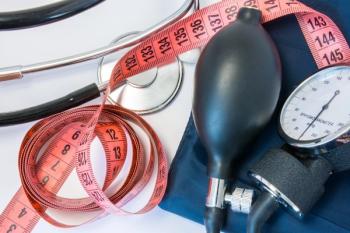
The American Journal of Managed Care
- September 2025
- Volume 31
- Issue 9
- Pages: e244-e248
Effect of Remote Patient Monitoring on Stage 2 Hypertension
A community-based remote patient monitoring (RPM) program was associated with significant reduction in blood pressure in Medicare patients with stage 2 hypertension, highlighting the potential benefits of RPM with care coaching.
ABSTRACT
Objectives: Remote patient monitoring (RPM) is increasingly being utilized in clinical practice to reduce blood pressure in patients with hypertension. RPM depends on home readings by patients electronically transmitted to clinicians and includes automated alerts for excessive abnormal readings. Data demonstrating the efficacy of RPM are limited; moreover, no study has specifically addressed patients with stage 2 hypertension. The current study aimed to address this gap.
Study Design: Quasi-experimental retrospective cohort study.
Methods: A cohort of community-dwelling Medicare patients in a large outpatient primary care practice was enrolled in an RPM program if they were diagnosed with hypertension. Patients were followed for 1 year. Each patient was also assigned a nurse to function as a care coach, who communicated with the patients monthly and provided at least 20 minutes of care management.
Results: Of the 3403 Medicare beneficiaries who consented to participate, 1594 actively engaged in the program for 1 year. Of these, 652 had stage 2 hypertension (systolic blood pressure [SBP] ≥ 140 mm Hg and/or diastolic BP [DBP] ≥ 90 mm Hg). The initial mean SBP/DBP ratio for those with stage 2 hypertension was 152/85 mm Hg, which decreased to 132/74 mm Hg by month 12. At baseline, 100% of these 652 patients met the criteria for stage 2 hypertension, but by month 12, this percentage decreased to 25%. In the 163 patients who remained in stage 2 hypertension, a notable decrease in BP was also achieved, with the mean BP dropping from 155/87 mm Hg to 146/77 mm Hg (P < .05).
Conclusions: Deployment of an RPM program in Medicare patients with concomitant care coaching was associated with statistically significant reductions in both elevated BP readings and the presence of stage 2 hypertension.
Am J Manag Care. 2025;31(9):e244-e248.
Takeaway Points
This study demonstrates the association between remote patient monitoring (RPM) with care coaching and a significant reduction in high blood pressure in Medicare patients.
- RPM was associated with a 75% reduction in stage 2 hypertension over 12 months.
- Patients benefited from real-time health monitoring and proactive care interventions.
- RPM plays a supportive role in managing chronic diseases and enhancing patient engagement.
Hypertension remains a significant public health concern worldwide, contributing to a substantial burden of cardiovascular disease and related mortality and leading to an annual health care cost of approximately $131 billion in the US.1 Annual medical costs for individuals with hypertension are up to $2500 higher than for those without the condition.2 Among hypertensive conditions, stage 2 hypertension, characterized by a systolic blood pressure (SBP) of at least 140 mm Hg and/or a diastolic BP (DBP) of at least 90 mm Hg, is of particular concern because it is associated with a higher risk of severe cardiovascular events and mortality.3,4 Successful management of stage 2 hypertension is critical for mitigating these risks, necessitating comprehensive approaches, including early detection, regular monitoring, and effective intervention strategies.5 Regular home BP monitoring is essential because it helps eliminate inaccuracies caused by white-coat hypertension and/or masked hypertension and provides vastly more data than the typical 2 to 3 annual clinic measurements. Recent advancements in telemedicine and health informatics have enhanced hypertension management, enabling more consistent and detailed monitoring of patient BP over extended periods.6 These technologies also facilitate timely interventions and personalized treatment plans, potentially improving outcomes in patients with stage 2 hypertension.7
In particular, the introduction of Medicare billing codes for remote physiological monitoring, commonly called remote patient monitoring (RPM), in 2019 (Current Procedural Terminology [CPT] codes 99453, 99454, 99457, and 99458) has significantly enhanced the adoption of home monitoring. These codes provide reimbursement for the setup and education of monitoring devices as well as for the ongoing collection, interpretation, and management of physiological data.8 According to the 2024 Medicare Physician Fee Schedule, the national payment amounts are approximately $55 for CPT code 99454 (device supply with daily recordings) and $50 for CPT code 99457 (20 minutes of remote monitoring and management).9 If both codes are billed every month, the annual cost of providing RPM is $1260, approximately half the cost of unsuccessfully treated hypertension. Therefore, by facilitating early intervention and continuous management, RPM can enhance patient outcomes and potentially reduce overall health care expenditures.
The clinical and financial benefits of these developments have encouraged health care providers to integrate remote monitoring into their cardiovascular management protocols, offering a scalable solution for tracking physiological data essential for managing patients’ health and well-being. Furthermore, the deployment of personalized care coaching encouraged by these codes adds value to this modality.
Understanding the long-term trends in BP control among these patients remains crucial for optimizing treatment strategies and health care resource allocation.8 In this study, we aimed to analyze the effect of RPM on the BP trends of patients diagnosed with stage 2 hypertension over a 1-year period, utilizing a comprehensive data set from a single health care system in the Northeast US collected by a proprietary platform. By examining systolic and diastolic BP readings at baseline and at subsequent intervals of 1 month, 3 months, 6 months, 9 months, and 12 months, we sought to identify patterns in BP control and the prevalence of sustained hypertension despite ongoing monitoring and management. This analysis provides valuable insights into the effectiveness of RPM and highlights areas for potential improvement. To our knowledge, this is the first study of RPM specifically looking at a population with stage 2 hypertension.
METHODS
Study Population
A list of patients was provided by a large medical group in the Northeast region of the US based on the International Statistical Classification of Diseases, Tenth Revision diagnostic code for hypertension. All the patients included in the initial cohort were Medicare recipients, most of whom were older than 65 years. From this initial cohort, 3403 patients consented to participate in this study.
Inclusion Criteria
Patients were included in the final analysis only if they had CPT billing codes 99454 (indicating remote monitoring devices and data transmission) or 99457 (indicating professional data evaluation including 1 interactive communication with the patient) every month within the 12-month period.
Doctor’s Discretion
Physicians had the authority to add or remove patients from the initial list or to remove them from the study on a case-by-case basis.
RPM Vendor
All services, including data management, analysis, care coaching, and onboarding, were provided by RPM Healthcare (RPMH), a corporation that employed, trained, and managed the RPM staff. The dashboard and electronic health record (EHR) integration were proprietary and developed by RPMH. All device logistics were managed using RPMH.
Patient Enrollment and Assignment
Patients were contacted by the RPMH onboarding team, given an explanation of the program, and offered the option to participate. After obtaining patient consent, the providers were notified, and the devices were shipped. Each patient was assigned a care coach (CC) who was a licensed practical nurse licensed in the patient’s state. The CCs provided regular monitoring and guidance to the patients throughout the program. This individualized assignment ensured the continuity of care, adherence, and familiarity with local resources.
Equipment and Data Transmission
All patients were provided with a cellular BP home monitoring device. These devices transmit all BP readings directly to the RPM dashboard and providers’ EHR systems via cellular route, ensuring seamless integration and near real-time monitoring. The devices are manually placed on the upper arm by the patient at the time of the reading. A cell phone application reminded patients to take their readings daily. There were no reported transmission errors.
Alerts and Follow-Up
Alerts were configured within the dashboard to notify CCs of BP readings above or below the prescribed values. CCs contacted patients in near real time during working hours for alerts. After working hours, notifications were managed by a call center. This protocol ensured timely intervention and management of abnormal readings, with the goal of maintaining optimal BP control.
Care Management/Clinical Team
CCs were trained using the RPMH dashboard. They received extensive education on hypertension management, the Patient Activation Measure, motivational interviewing, and social determinants of health (SDOH). This comprehensive training enabled nurses to build rapport quickly, actively listen to patients, and address barriers to adherence. Ongoing training through individual and group meetings ensured continuous improvement. On the monthly call, CCs provided coaching on lifestyle changes, including adopting the Dietary Approaches to Stop Hypertension diet, introducing or enhancing an exercise routine, maintaining adequate sleep and practicing good sleep hygiene, utilizing stress reduction techniques, and ensuring medication adherence. Additionally, the team assessed SDOH and provided resources to address barriers to care. CCs advised patients to consult their health care provider for medication adjustments as needed based on the BP trend. Some patients required an increased dosage or the addition of another medication class, whereas others were able to reduce their dosage as their condition improved. Each nurse provided monitoring and guidance throughout the month to 300 to 350 patients.
Additional Services Provided
Every patient was also invited to attend a live monthly webinar led by a clinician who focused on hypertension management and diverse lifestyle changes. Topics included diet, sleep, exercise, and relaxation techniques such as breathing and meditation, with each session highlighting a specific area of interest. Patients could text their CCs at any time with questions or concerns. Additionally, those needing detailed dietary guidance had the option of working with a registered dietitian as their CC, ensuring personalized support tailored to their needs.
Statistical Analysis
Data were collected via a proprietary dashboard and database maintained by RPMH. These data were exported to a statistical analysis software, RPM365 1.0 (RPM Healthcare, LLC).
We used repeated-measures analysis of variance to evaluate changes in SBP and DBP across 6 time points (baseline, 1 month, 3 months, 6 months, 9 months, and 12 months). Statistical significance was set at P < .05.
To assess the trend in the prevalence of stage 2 hypertension (defined as SBP ≥ 140 mm Hg and/or DBP ≥ 90 mm Hg), we performed a χ2 test for trends across the same time points. This test determined whether the reduction in stage 2 hypertension over time was statistically significant.
RESULTS
Patient Demographics
Of the 3403 patients who consented to participate in the program, 1594 actively participated continuously for 1 full year. All patients were Medicare beneficiaries, 88.2% of whom were older than 65 years. Of the 1594 patients, 652 were identified as having stage 2 hypertension based on the initial reading. This group had a mean age of 74 years (range, 24-102 years), and 58.4% were female.
BP Readings
BP was monitored in 652 patients with stage 2 hypertension. The mean SBP and DBP were recorded at baseline (first reading) and then at intervals of 1 month and 3, 6, 9, and 12 months. At the initial reading, the mean SBP and DBP were 152 mm Hg and 85 mm Hg, respectively. By the first month, these means had decreased to 143 mm Hg for SBP and 80 mm Hg for DBP. At the 3-month mark, they further dropped to 135 mm Hg for SBP and 76 mm Hg for DBP. By the sixth month, the mean SBP and DBP were 134 mm Hg and 75 mm Hg, respectively, further decreasing by the ninth month to 131 mm Hg and 74 mm Hg. At the 12th month, the mean was 132 mm Hg for SBP and 74 mm Hg for DBP (
Additionally, the percentage of patients with stage 2 hypertension was tracked at each time point. Initially, 100% of these patients met the criteria for stage 2 hypertension, but by the first month, this percentage had dropped to 60.58% (395/652). By the third month, it had decreased to 38.80% (253/652), and by the sixth month, it was 32.82% (214/652). At 9 months, the percentage of patients with stage 2 hypertension was 26.99% (176/652), and by the month, it had decreased to 25.00% (163/652).
As previously noted, the mean initial BP was 152/85 mm Hg in patients with stage 2 hypertension, with a median BP of 149/85 mm Hg. By the 12th month, 163 of these 652 patients remained in stage 2 hypertension. In this group, the mean BP decreased to 146/77 mm Hg and the median BP was 145/77 mm Hg. This subset of patients had an initial mean BP of 155/87 mm Hg and an initial median BP of 153/87 mm Hg. Despite still meeting the criteria for stage 2 hypertension, the BP showed a significant reduction (P < .05).
The mean number of BP readings at the end of the first month was 16 readings per 30 days; for months 3 through 12, the mean number of readings had increased to 25 per 30-day period (
DISCUSSION
The primary objective of this study was to evaluate the association between RPM with care coaching and BP control among patients with stage 2 hypertension over a 12-month period. Our findings provide meaningful insights into the potential role of this approach in hypertension management.
Interpretation of Findings
The data indicate a substantial initial reduction in both SBP and DBP among the 652 patients with stage 2 hypertension. At the first reading, the mean SBP and DBP were 152 mm Hg and 85 mm Hg, respectively. These values dropped to 143 mm Hg and 80 mm Hg, respectively, after 1 month, indicating marked improvement in BP control. Over the subsequent months, the mean SBP and DBP continued to decline, reaching 132 mm Hg and 74 mm Hg, respectively, by the 12th month.
The percentage of patients with stage 2 hypertension also decreased dramatically at each time point, dropping to 60.58% after the first month and to 25% by month 12. Achieving a substantial improvement of 75% in disease burden is rare in health care, especially with noninvasive interventions. This success highlights the power of RPM combined with personalized care coaching to facilitate better adherence, timely intervention, and improved overall health outcomes for patients. Although a 75% reduction in disease burden is clinically meaningful, it is important to note that 25% of patients receiving intensive treatment for 1 year continued to have stage 2 hypertension. However, this group did exhibit a statistically significant reduction in mean and median BPs despite still being categorized as having stage 2 hypertension, which may be beneficial in reducing complication rates. This persistent elevation in a subset of patients underscores the need for more tailored and intensive management strategies as well as a longer duration of monitoring. These results are consistent with previous findings, suggesting that a considerable proportion of patients with hypertension do not achieve optimal BP control despite ongoing treatment.
Implications for Clinical Practice
The deployment of CCs, each responsible for 300 to 350 patients, likely played a crucial role in the observed improvements. CCs provided continuous support and monitoring facilitated by telemedicine tools, which enabled timely interventions and adjustments to treatment plans. Indeed, studies have shown that the addition of care coaching improves outcomes compared with RPM alone.10 The use of cellular BP home monitoring cuffs ensured accurate and easy real-time data transmission to providers’ EHR systems. This integration allowed for efficient tracking of patient progress and prompt responses to abnormal readings.
This study demonstrated an association between RPM and improved BP trends in 75% of patients with stage 2 hypertension. In fact, even the 25% of patients who remained in stage 2 by 12 months still had a significant lowering of BP. This raises the possibility that extending RPM to a longer period in certain patients could provide additional improvements. This finding underscores the importance of continued, and perhaps more individualized, monitoring beyond the first year.
We believe the success of RPM in association with BP reduction in stage 2 hypertension was likely due to several factors. CCs were able to ensure patients’ increased adherence to medications, dietary interventions, and regular physical activity. Furthermore, they helped facilitate increased sleep and stress reduction. Through CCs’ collaboration with the referring providers and provision of near real-time BP data, medications were often adjusted, changed, or added—interventions that likely would not have occurred without the RPM program.
Technological Integration and Future Directions
The use of telemedicine and health informatics tools in this study exemplifies the potential of technology to enhance hypertension management. The ability to frequently and consistently monitor patients and provide real-time feedback is invaluable for managing chronic conditions such as hypertension. Future research should focus on optimizing these technological interventions to improve patient outcomes. Additionally, exploring the integration of artificial intelligence to predict and preemptively address BP spikes and enhance patient communication and education could be a promising avenue.11
Limitations
This study has several limitations. First, the patient population was limited to Medicare recipients, the majority of whom were older than 65 years, which may limit the generalizability of the findings to younger populations or those with different insurance coverage. A key limitation of our study is the attrition rate, as only 47% of patients who initially enrolled in the RPM program remained actively engaged for the full 12 months. This could result in an overestimation of the association between RPM and BP improvement because patients who discontinued the program may have done so for reasons that could influence outcomes, such as perceived control of BP or nonadherence. Although we recognize the value of modeling attrition using longitudinal methods or conducting a sensitivity analysis with less than full engagement (eg, 9 of 12 months), such an analysis was not feasible due to the lack of complete data on reasons for discontinuation or partial engagement. This limitation underscores the need for future research to explore the relationship among length of engagement, changes in BP, and outcomes for patients with varying levels of adherence. Furthermore, the study reviewed 2 interventions, remote monitoring and nursing care coaching, together, with no ability to evaluate each intervention separately. Additionally, the use of a single health care system in one geographical area limited the generalizability of the study. Finally, the observational nature of the study and the lack of a control group precluded definitive conclusions regarding causality.
CONCLUSIONS
This study highlights the association of RPM and care coaching with BP control in patients with stage 2 hypertension. Over 12 months, stage 2 hypertension was resolved in 75% of the patients, suggesting that RPM is a promising, noninvasive approach. Although 25% of the patients still had stage 2 hypertension at month 12, their mean BP levels had improved significantly, indicating the potential need for more personalized management strategies. However, patient attrition remains an important limitation, as only 47% of the initial cohort remained fully engaged for the entire study period. Understanding the reasons behind disengagement and its potential impact on outcomes will be critical for future research to optimize RPM programs and enhance long-term adherence. Future studies could explore extended RPM engagement beyond 12 months and incorporate advanced technologies, such as artificial intelligence, to enhance monitoring and personalized care. Ongoing research and tailored treatment plans remain essential for maximizing the long-term benefits of RPM and expanding its application to other chronic or acute conditions.
Author Affiliations: RPM Healthcare (LD, IK), St Petersburg, FL.
Source of Funding: None.
Author Disclosures: Dr Dennis is the chief medical officer of RPM Healthcare. Dr Koyfman is the chief clinical officer of RPM Healthcare.
Authorship Information: Concept and design (LD, IK); acquisition of data (LD, IK); analysis and interpretation of data (LD, IK); drafting of the manuscript (LD, IK); critical revision of the manuscript for important intellectual content (LD, IK); statistical analysis (LD); provision of patients or study materials (LD); obtaining funding (LD); administrative, technical, or logistic support (LD); and supervision (LD).
Address Correspondence to: Irina Koyfman, DNP, NP-C, RN, RPM Healthcare, 321 Chamborley Dr, Reisterstown, MD 21136. Email: irinak@rpmhealthcare.com.
REFERENCES
1. Controlling high blood pressure. eCQI Resource Center. Updated June 3, 2024. Accessed December 21, 2024.
2. Health and economic benefits of high blood pressure interventions. CDC. December 9, 2024. Accessed December 19, 2024.
3. Timmis A, Aboyans V, Vardas P, et al; ESC National Cardiac Societies. European Society of Cardiology: the 2023 atlas of cardiovascular disease statistics. Eur Heart J. 2024;45(38):4019-4062. doi:10.1093/eurheartj/ehae466
4. Mills KT, Bundy JD, Kelly TN, et al. Global disparities in hypertension prevalence and control: a systematic analysis of population-based studies from 90 countries. Circulation. 2016;134(6):441-50. doi:10.1161/CIRCULATIONAHA.115.018912
5. Carey RM, Whelton PK; 2017 ACC/AHA Hypertension Guideline Writing Committee. Prevention, detection, evaluation, and management of high blood pressure in adults: synopsis of the 2017 American College of Cardiology/American Heart Association hypertension guideline. Ann Intern Med. 2018;168(5):351-358. doi:10.7326/M17-3203
6. Mancia G, Kreutz R, Brunström M, et al. 2023 ESH Guidelines for the management of arterial hypertension: the task force for the management of arterial hypertension of the European Society of Hypertension: endorsed by the International Society of Hypertension (ISH) and the European Renal Association (ERA). J Hypertens. 2023;41(12):1874-2071. doi:10.1097/HJH.0000000000003480
7. Bushnell C. Achieving blood pressure goals and addressing inequities in blood pressure management after stroke. J Am Heart Assoc. 2024;13(7):e031307. doi:10.1161/JAHA.123.031307
8. Abbasi-Feinberg F. Telemedicine coding and reimbursement - current and future trends. Sleep Med Clin. 2020;15(3):417-429. doi:10.1016/j.jsmc.2020.06.002
9. Physician Fee Schedule. CMS. Updated November 5, 2024. Accessed January 2, 2025.
10. Blood AJ, Cannon CP, Gordon WJ, et al. Results of a remotely delivered hypertension and lipid program in more than 10 000 patients across a diverse health care network. JAMA Cardiol. 2023;8(1):12-21. doi:10.1001/jamacardio.2022.4018
11. Tan SY, Sumner J, Wang Y, Wenjun Yip A. A systematic review of the impacts of remote patient monitoring (RPM) interventions on safety, adherence, quality-of-life and cost-related outcomes. NPJ Digit Med. 2024;7(1):192. doi:10.1038/s41746-024-01182-w
Articles in this issue
3 months ago
Overcoming Weight Bias in Health Care Systems3 months ago
State Restrictions on Prior AuthorizationNewsletter
Stay ahead of policy, cost, and value—subscribe to AJMC for expert insights at the intersection of clinical care and health economics.














































